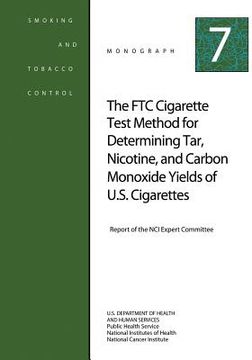Share
The FTC Cigarette Test Method for Determining Tar, Nicotine, and Carbon Monoxide Yields of U.S. Cigarettes: Smoking and Tobacco Control Monograph No. (in English)
U. S. Department of Heal Human Services
(Author)
·
National Cancer Institute
(Author)
·
Createspace Independent Publishing Platform
· Paperback
The FTC Cigarette Test Method for Determining Tar, Nicotine, and Carbon Monoxide Yields of U.S. Cigarettes: Smoking and Tobacco Control Monograph No. (in English) - Health, National Institutes of ; Institute, National Cancer ; Human Services, U. S. Department of Heal
$ 19.19
$ 23.99
You save: $ 4.80
Choose the list to add your product or create one New List
✓ Product added successfully to the Wishlist.
Go to My WishlistsIt will be shipped from our warehouse between
Tuesday, July 02 and
Wednesday, July 03.
You will receive it anywhere in United States between 1 and 3 business days after shipment.
Synopsis "The FTC Cigarette Test Method for Determining Tar, Nicotine, and Carbon Monoxide Yields of U.S. Cigarettes: Smoking and Tobacco Control Monograph No. (in English)"
In response to the emerging scientific evidence that cigarette smoking posed a significant health risk to the user, in the early 1950's the major cigarette manufacturers began widespread promotion of filtered cigarettes to reassure smokers that, regardless of whatever unhealthy constituents were in cigarette smoke, filters were a "scientific" breakthrough. Advertisements for Viceroy's "health guard filter" stated, "DENTISTS ADVISE-Smoke VICEROYS-The Nicotine and Tars Trapped by The Viceroy Filter CAN NEVER STAIN YOUR TEETH!" and "Leading N.Y. Doctor Tells His Patients What to Smoke-Filtered Cigarette Smoke Is Better For Health. The Nicotine and Tars Trapped ... Cannot Reach Mouth, Throat Or Lungs." Chesterfield was "Best for you-low in nicotine, highest in quality," while L&M's were "Just What the Doctor Ordered." Lorillard Tobacco Company stressed its science-based Kent micronite filter (the original micronite filter was made of asbestos) and claimed it removed seven times more tar and nicotine than any other cigarette, which "put Kent in a class all by itself where health protection is concerned." Of course, we know today that not only were these claims patently false, but the cigarette companies knew, it. In the early 1950's the Federal Trade Commission (FTC) challenged a variety of health claims made for cigarettes in their advertising, including claims about tar and nicotine. In 1955 FTC published advertising guidelines that, among other things, prohibited claims by cigarette manufacturers that a particular brand of cigarettes was low in tar and nicotine or lower than other brands, when it had not been established by competent scientific proof that the claim was true and the difference was significant. Cigarette manufactures, however, continued to advertise tar numbers. In the absence of a standardized test methodology, this resulted in what is referred to as a "tar derby"-a multitude of inconsistent, noncomparable claims that did not give consumers a meaningful opportunity to assess the relative tar delivery of competing brands. The tar derby ended in 1960 when discussions with FTC culminated in an industry agreement to refrain from tar and nicotine advertising. In 1966, however, the U.S. Public Health Service (PHS) prepared a technical report on "tar" and nicotine that concluded, "The preponderance of scientific evidence strongly suggests that the lower the 'tar' and nicotine content of cigarette smoke, the less harmful would be the effect." In reaching this conclusion, the report noted the clear relationship between dose of cigarette smoke received by the smoker and disease risk. Regardless of how dose was calculated-by number of cigarettes smoked per day, age of initiation, total number of years one smoked, or depth of inhalation, mortality rates among smokers increased. When smokers quit smoking, their risk was reduced in proportion to the length of time off cigarettes.

